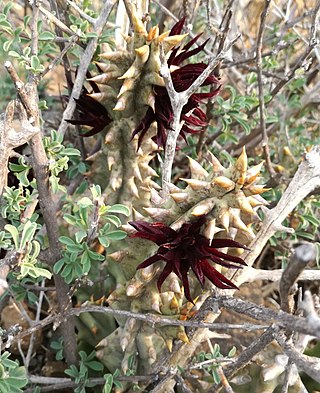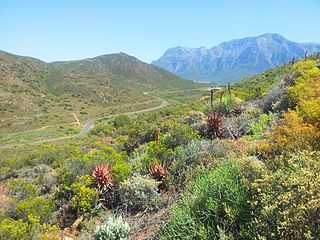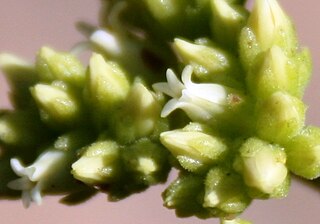
Haworthia is a large genus of small succulent plants endemic to Southern Africa (Mozambique, Namibia, Lesotho, Eswatini and South Africa).

Gasteria is a genus of succulent plants, native to South Africa and the far south-west corner of Namibia.

Gasteria excelsa is a succulent plant, native to the Eastern Cape Province, South Africa.

The genus Quaqua falls within the tribe of plants known collectively as stapeliads. All stapeliads, including Quaqua, are Old World stem succulents.

Gasteria armstrongii is a dwarf succulent plant native to South Africa, in the genus Gasteria.

Glottiphyllum longum is a species of succulent plant in the family Aizoaceae, native to the Western Cape and Eastern Cape Provinces, South Africa.

Haworthia truncata, locally known as horse's teeth, is a species of succulent plant in the genus Haworthia. It is found in the Little Karoo region, in the far east of the Western Cape Province, South Africa.

Robertson Karoo is a semi-arid vegetation type, restricted to sections of the Breede River Valley, Western Cape Province, South Africa. It is a subtype of Succulent Karoo and is characterised by the dominance of succulent plant species, and by several endemic plants and animals.

Gasteria acinacifolia is succulent plant native to the Eastern Cape Province, South Africa.

Gasteria rawlinsonii is succulent plant of the genus Gasteria native to South Africa.

Gasteria pillansii is succulent plant native to the arid winter-rainfall regions in the far west of South Africa and Namibia.

Gasteria bicolor is a species of succulent flowering plant in the family Asphodelaceae, native to the Eastern Cape, South Africa.

Gasteria nitida, the Bathurst gasteria, is a succulent plant, native to the Eastern Cape grasslands of South Africa.

Gasteria batesiana is a species of succulent plant, native to the inland escarpment in the far north-east of South Africa.

Gasteria carinata is a small and variable succulent plant, native to the Western Cape Province, South Africa.

Gasteria brachyphylla is succulent plant native to the Western Cape, South Africa.

Gasteria croucheri is a succulent plant, native to KwaZulu-Natal Province, South Africa.

Gasteria baylissiana, Suurberg gasteria, is a species of succulent flowering plant in the family Asphodelaceae, native to the Eastern Cape, South Africa.

Glottiphyllum oligocarpum is a species of succulent plant, in the family Aizoaceae. It is indigenous to arid areas of the Little Karoo, in the Western Cape, South Africa.

Crassula atropurpurea is a succulent plant, very common and widespread in the southern Karoo regions of South Africa and Namibia.




















